MgMT20144: Business Case Analysis of Huawei Enterprise USA Inc.
VerifiedAdded on 2022/10/01
|7
|2062
|320
Report
AI Summary
This report presents a business case analysis of Huawei Enterprise USA Inc., examining its business and governance structures, including the roles of the Board of Directors, Executive Committee, and Supervisory Board. It identifies key environmental factors impacting the company, such as political, economic, social, and technological influences, and discusses the company's adaptation to the US market. The report also highlights the major risks faced by Huawei, including competition and intellectual property disputes, and analyzes the company's business practices, such as the establishment of the ICT infrastructure Managing Board and Consumer Business Managing Board, and the use of functional departments to support its operations. Furthermore, the analysis concludes that Huawei is operating well in the American market despite challenges, focusing on customer satisfaction and adapting to a fast-changing environment. The report references several academic sources to support its findings.
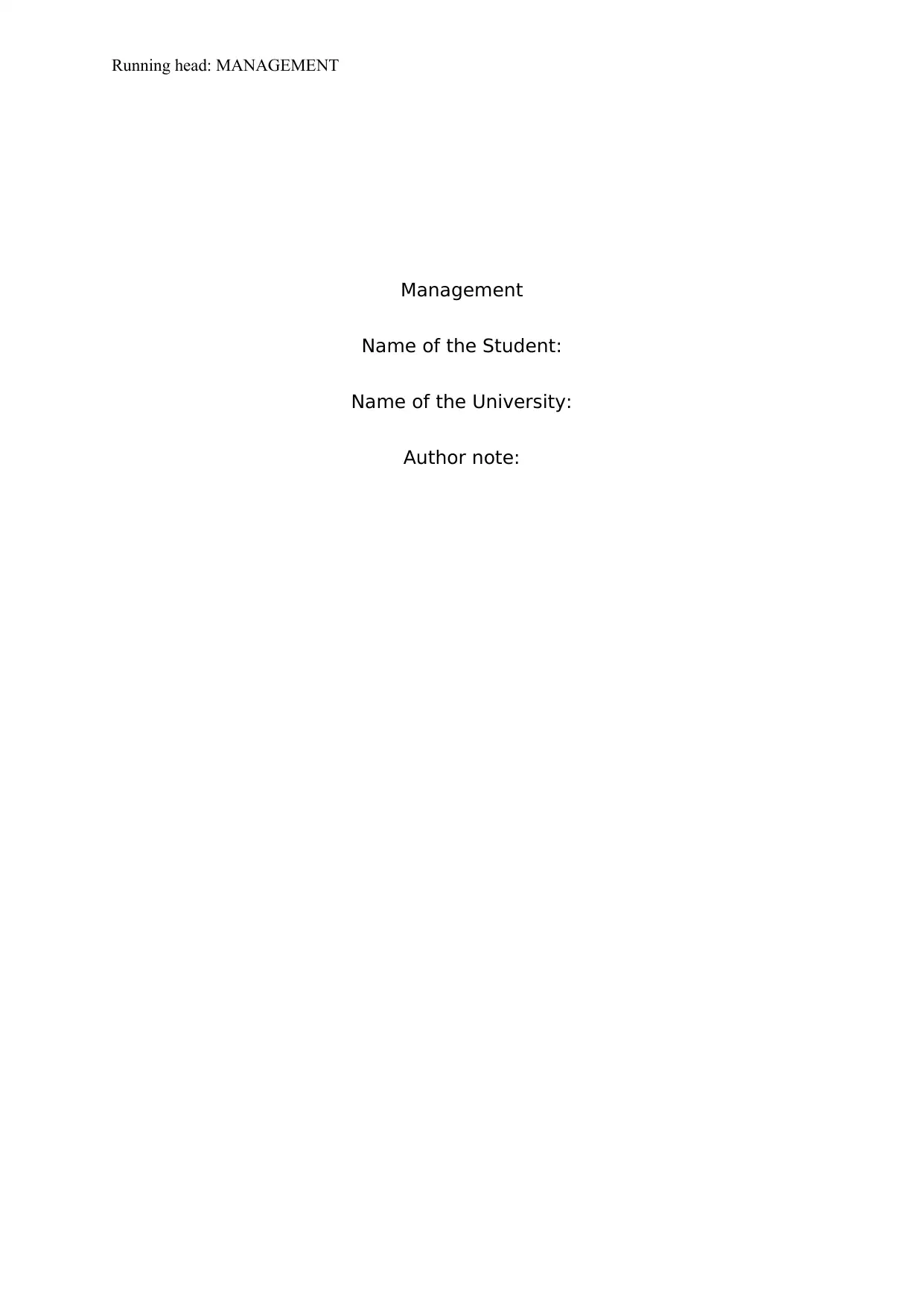
Running head: MANAGEMENT
Management
Name of the Student:
Name of the University:
Author note:
Management
Name of the Student:
Name of the University:
Author note:
Paraphrase This Document
Need a fresh take? Get an instant paraphrase of this document with our AI Paraphraser
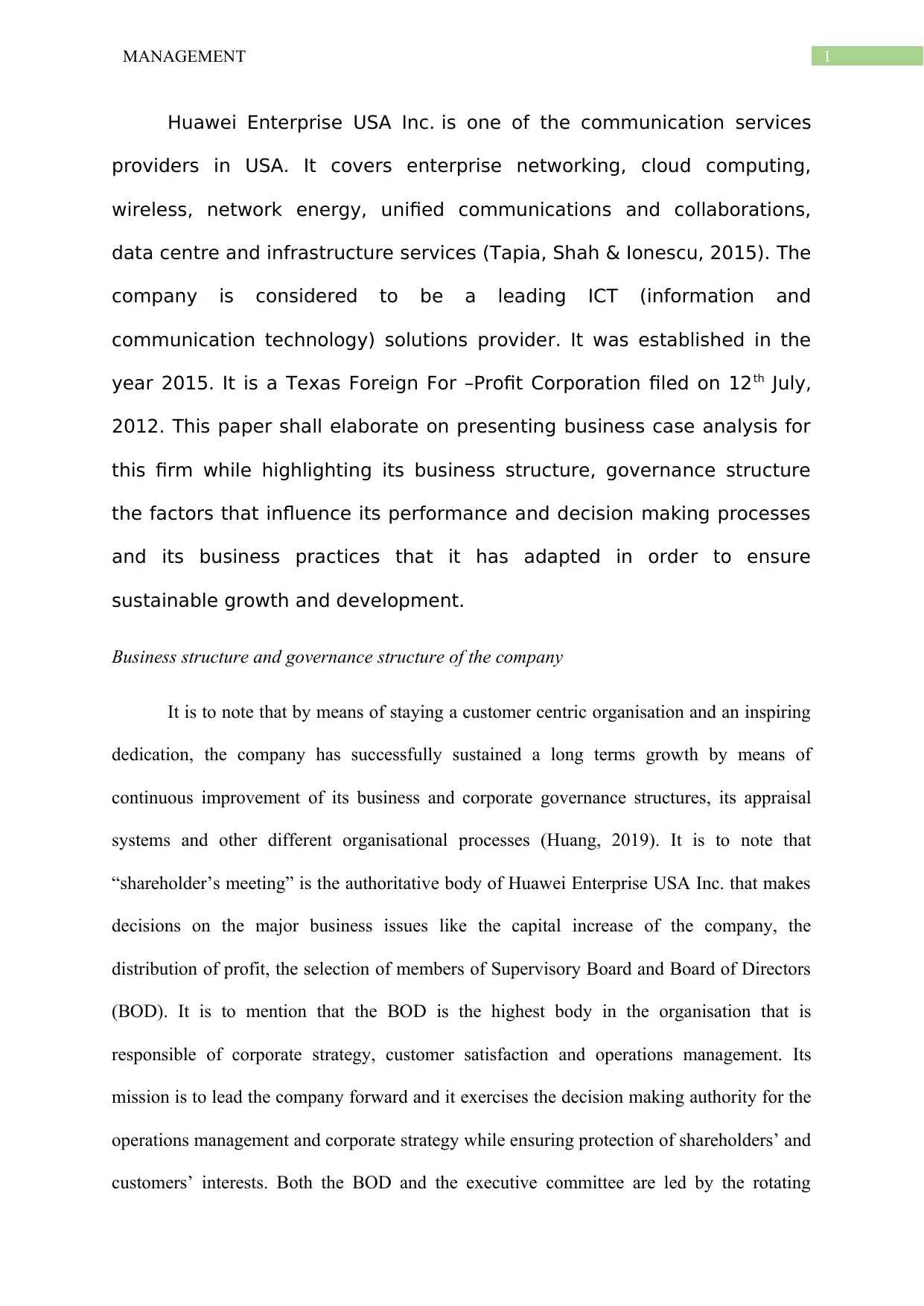
1MANAGEMENT
Huawei Enterprise USA Inc. is one of the communication services
providers in USA. It covers enterprise networking, cloud computing,
wireless, network energy, unified communications and collaborations,
data centre and infrastructure services (Tapia, Shah & Ionescu, 2015). The
company is considered to be a leading ICT (information and
communication technology) solutions provider. It was established in the
year 2015. It is a Texas Foreign For –Profit Corporation filed on 12th July,
2012. This paper shall elaborate on presenting business case analysis for
this firm while highlighting its business structure, governance structure
the factors that influence its performance and decision making processes
and its business practices that it has adapted in order to ensure
sustainable growth and development.
Business structure and governance structure of the company
It is to note that by means of staying a customer centric organisation and an inspiring
dedication, the company has successfully sustained a long terms growth by means of
continuous improvement of its business and corporate governance structures, its appraisal
systems and other different organisational processes (Huang, 2019). It is to note that
“shareholder’s meeting” is the authoritative body of Huawei Enterprise USA Inc. that makes
decisions on the major business issues like the capital increase of the company, the
distribution of profit, the selection of members of Supervisory Board and Board of Directors
(BOD). It is to mention that the BOD is the highest body in the organisation that is
responsible of corporate strategy, customer satisfaction and operations management. Its
mission is to lead the company forward and it exercises the decision making authority for the
operations management and corporate strategy while ensuring protection of shareholders’ and
customers’ interests. Both the BOD and the executive committee are led by the rotating
Huawei Enterprise USA Inc. is one of the communication services
providers in USA. It covers enterprise networking, cloud computing,
wireless, network energy, unified communications and collaborations,
data centre and infrastructure services (Tapia, Shah & Ionescu, 2015). The
company is considered to be a leading ICT (information and
communication technology) solutions provider. It was established in the
year 2015. It is a Texas Foreign For –Profit Corporation filed on 12th July,
2012. This paper shall elaborate on presenting business case analysis for
this firm while highlighting its business structure, governance structure
the factors that influence its performance and decision making processes
and its business practices that it has adapted in order to ensure
sustainable growth and development.
Business structure and governance structure of the company
It is to note that by means of staying a customer centric organisation and an inspiring
dedication, the company has successfully sustained a long terms growth by means of
continuous improvement of its business and corporate governance structures, its appraisal
systems and other different organisational processes (Huang, 2019). It is to note that
“shareholder’s meeting” is the authoritative body of Huawei Enterprise USA Inc. that makes
decisions on the major business issues like the capital increase of the company, the
distribution of profit, the selection of members of Supervisory Board and Board of Directors
(BOD). It is to mention that the BOD is the highest body in the organisation that is
responsible of corporate strategy, customer satisfaction and operations management. Its
mission is to lead the company forward and it exercises the decision making authority for the
operations management and corporate strategy while ensuring protection of shareholders’ and
customers’ interests. Both the BOD and the executive committee are led by the rotating
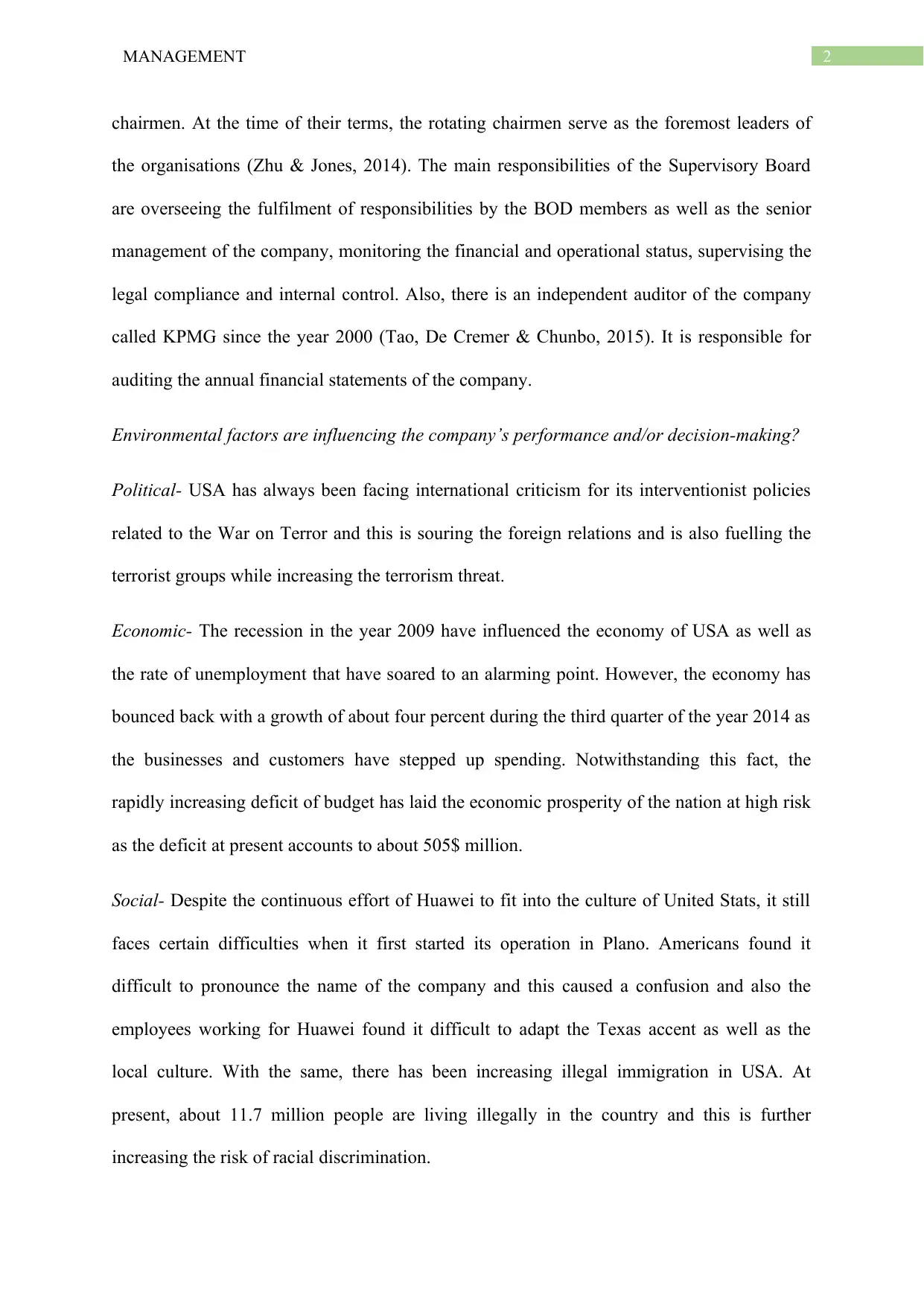
2MANAGEMENT
chairmen. At the time of their terms, the rotating chairmen serve as the foremost leaders of
the organisations (Zhu & Jones, 2014). The main responsibilities of the Supervisory Board
are overseeing the fulfilment of responsibilities by the BOD members as well as the senior
management of the company, monitoring the financial and operational status, supervising the
legal compliance and internal control. Also, there is an independent auditor of the company
called KPMG since the year 2000 (Tao, De Cremer & Chunbo, 2015). It is responsible for
auditing the annual financial statements of the company.
Environmental factors are influencing the company’s performance and/or decision-making?
Political- USA has always been facing international criticism for its interventionist policies
related to the War on Terror and this is souring the foreign relations and is also fuelling the
terrorist groups while increasing the terrorism threat.
Economic- The recession in the year 2009 have influenced the economy of USA as well as
the rate of unemployment that have soared to an alarming point. However, the economy has
bounced back with a growth of about four percent during the third quarter of the year 2014 as
the businesses and customers have stepped up spending. Notwithstanding this fact, the
rapidly increasing deficit of budget has laid the economic prosperity of the nation at high risk
as the deficit at present accounts to about 505$ million.
Social- Despite the continuous effort of Huawei to fit into the culture of United Stats, it still
faces certain difficulties when it first started its operation in Plano. Americans found it
difficult to pronounce the name of the company and this caused a confusion and also the
employees working for Huawei found it difficult to adapt the Texas accent as well as the
local culture. With the same, there has been increasing illegal immigration in USA. At
present, about 11.7 million people are living illegally in the country and this is further
increasing the risk of racial discrimination.
chairmen. At the time of their terms, the rotating chairmen serve as the foremost leaders of
the organisations (Zhu & Jones, 2014). The main responsibilities of the Supervisory Board
are overseeing the fulfilment of responsibilities by the BOD members as well as the senior
management of the company, monitoring the financial and operational status, supervising the
legal compliance and internal control. Also, there is an independent auditor of the company
called KPMG since the year 2000 (Tao, De Cremer & Chunbo, 2015). It is responsible for
auditing the annual financial statements of the company.
Environmental factors are influencing the company’s performance and/or decision-making?
Political- USA has always been facing international criticism for its interventionist policies
related to the War on Terror and this is souring the foreign relations and is also fuelling the
terrorist groups while increasing the terrorism threat.
Economic- The recession in the year 2009 have influenced the economy of USA as well as
the rate of unemployment that have soared to an alarming point. However, the economy has
bounced back with a growth of about four percent during the third quarter of the year 2014 as
the businesses and customers have stepped up spending. Notwithstanding this fact, the
rapidly increasing deficit of budget has laid the economic prosperity of the nation at high risk
as the deficit at present accounts to about 505$ million.
Social- Despite the continuous effort of Huawei to fit into the culture of United Stats, it still
faces certain difficulties when it first started its operation in Plano. Americans found it
difficult to pronounce the name of the company and this caused a confusion and also the
employees working for Huawei found it difficult to adapt the Texas accent as well as the
local culture. With the same, there has been increasing illegal immigration in USA. At
present, about 11.7 million people are living illegally in the country and this is further
increasing the risk of racial discrimination.
⊘ This is a preview!⊘
Do you want full access?
Subscribe today to unlock all pages.

Trusted by 1+ million students worldwide
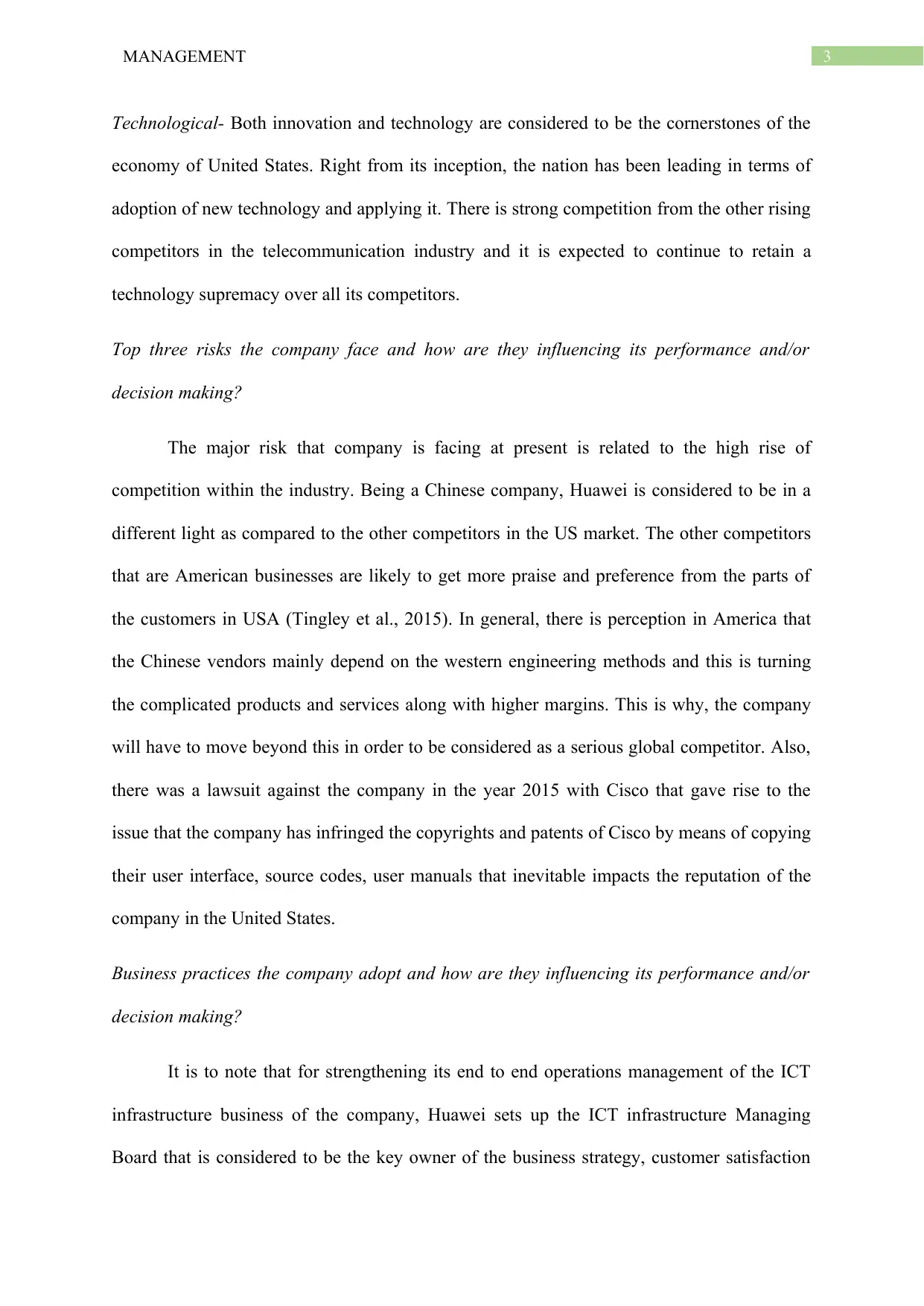
3MANAGEMENT
Technological- Both innovation and technology are considered to be the cornerstones of the
economy of United States. Right from its inception, the nation has been leading in terms of
adoption of new technology and applying it. There is strong competition from the other rising
competitors in the telecommunication industry and it is expected to continue to retain a
technology supremacy over all its competitors.
Top three risks the company face and how are they influencing its performance and/or
decision making?
The major risk that company is facing at present is related to the high rise of
competition within the industry. Being a Chinese company, Huawei is considered to be in a
different light as compared to the other competitors in the US market. The other competitors
that are American businesses are likely to get more praise and preference from the parts of
the customers in USA (Tingley et al., 2015). In general, there is perception in America that
the Chinese vendors mainly depend on the western engineering methods and this is turning
the complicated products and services along with higher margins. This is why, the company
will have to move beyond this in order to be considered as a serious global competitor. Also,
there was a lawsuit against the company in the year 2015 with Cisco that gave rise to the
issue that the company has infringed the copyrights and patents of Cisco by means of copying
their user interface, source codes, user manuals that inevitable impacts the reputation of the
company in the United States.
Business practices the company adopt and how are they influencing its performance and/or
decision making?
It is to note that for strengthening its end to end operations management of the ICT
infrastructure business of the company, Huawei sets up the ICT infrastructure Managing
Board that is considered to be the key owner of the business strategy, customer satisfaction
Technological- Both innovation and technology are considered to be the cornerstones of the
economy of United States. Right from its inception, the nation has been leading in terms of
adoption of new technology and applying it. There is strong competition from the other rising
competitors in the telecommunication industry and it is expected to continue to retain a
technology supremacy over all its competitors.
Top three risks the company face and how are they influencing its performance and/or
decision making?
The major risk that company is facing at present is related to the high rise of
competition within the industry. Being a Chinese company, Huawei is considered to be in a
different light as compared to the other competitors in the US market. The other competitors
that are American businesses are likely to get more praise and preference from the parts of
the customers in USA (Tingley et al., 2015). In general, there is perception in America that
the Chinese vendors mainly depend on the western engineering methods and this is turning
the complicated products and services along with higher margins. This is why, the company
will have to move beyond this in order to be considered as a serious global competitor. Also,
there was a lawsuit against the company in the year 2015 with Cisco that gave rise to the
issue that the company has infringed the copyrights and patents of Cisco by means of copying
their user interface, source codes, user manuals that inevitable impacts the reputation of the
company in the United States.
Business practices the company adopt and how are they influencing its performance and/or
decision making?
It is to note that for strengthening its end to end operations management of the ICT
infrastructure business of the company, Huawei sets up the ICT infrastructure Managing
Board that is considered to be the key owner of the business strategy, customer satisfaction
Paraphrase This Document
Need a fresh take? Get an instant paraphrase of this document with our AI Paraphraser
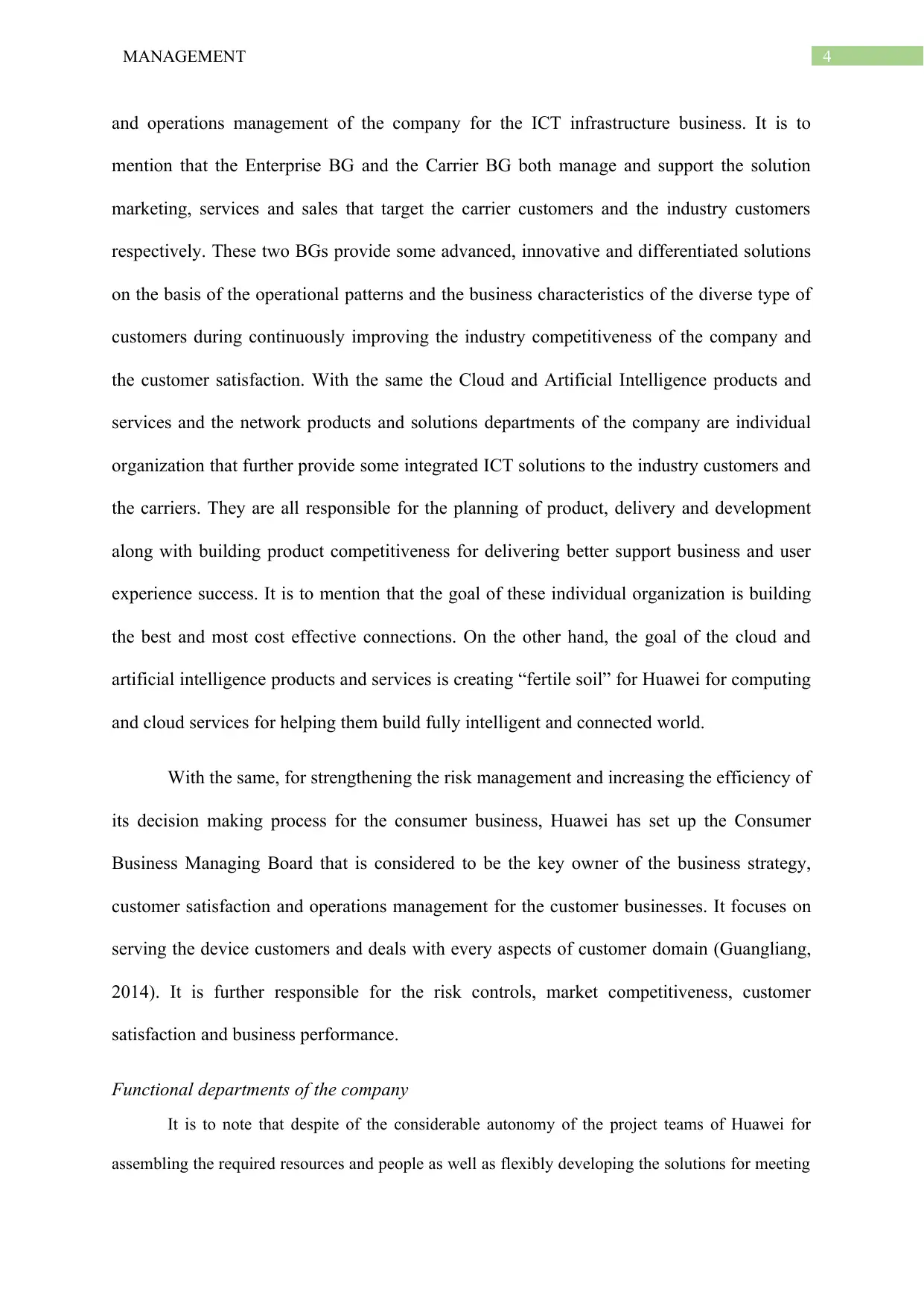
4MANAGEMENT
and operations management of the company for the ICT infrastructure business. It is to
mention that the Enterprise BG and the Carrier BG both manage and support the solution
marketing, services and sales that target the carrier customers and the industry customers
respectively. These two BGs provide some advanced, innovative and differentiated solutions
on the basis of the operational patterns and the business characteristics of the diverse type of
customers during continuously improving the industry competitiveness of the company and
the customer satisfaction. With the same the Cloud and Artificial Intelligence products and
services and the network products and solutions departments of the company are individual
organization that further provide some integrated ICT solutions to the industry customers and
the carriers. They are all responsible for the planning of product, delivery and development
along with building product competitiveness for delivering better support business and user
experience success. It is to mention that the goal of these individual organization is building
the best and most cost effective connections. On the other hand, the goal of the cloud and
artificial intelligence products and services is creating “fertile soil” for Huawei for computing
and cloud services for helping them build fully intelligent and connected world.
With the same, for strengthening the risk management and increasing the efficiency of
its decision making process for the consumer business, Huawei has set up the Consumer
Business Managing Board that is considered to be the key owner of the business strategy,
customer satisfaction and operations management for the customer businesses. It focuses on
serving the device customers and deals with every aspects of customer domain (Guangliang,
2014). It is further responsible for the risk controls, market competitiveness, customer
satisfaction and business performance.
Functional departments of the company
It is to note that despite of the considerable autonomy of the project teams of Huawei for
assembling the required resources and people as well as flexibly developing the solutions for meeting
and operations management of the company for the ICT infrastructure business. It is to
mention that the Enterprise BG and the Carrier BG both manage and support the solution
marketing, services and sales that target the carrier customers and the industry customers
respectively. These two BGs provide some advanced, innovative and differentiated solutions
on the basis of the operational patterns and the business characteristics of the diverse type of
customers during continuously improving the industry competitiveness of the company and
the customer satisfaction. With the same the Cloud and Artificial Intelligence products and
services and the network products and solutions departments of the company are individual
organization that further provide some integrated ICT solutions to the industry customers and
the carriers. They are all responsible for the planning of product, delivery and development
along with building product competitiveness for delivering better support business and user
experience success. It is to mention that the goal of these individual organization is building
the best and most cost effective connections. On the other hand, the goal of the cloud and
artificial intelligence products and services is creating “fertile soil” for Huawei for computing
and cloud services for helping them build fully intelligent and connected world.
With the same, for strengthening the risk management and increasing the efficiency of
its decision making process for the consumer business, Huawei has set up the Consumer
Business Managing Board that is considered to be the key owner of the business strategy,
customer satisfaction and operations management for the customer businesses. It focuses on
serving the device customers and deals with every aspects of customer domain (Guangliang,
2014). It is further responsible for the risk controls, market competitiveness, customer
satisfaction and business performance.
Functional departments of the company
It is to note that despite of the considerable autonomy of the project teams of Huawei for
assembling the required resources and people as well as flexibly developing the solutions for meeting
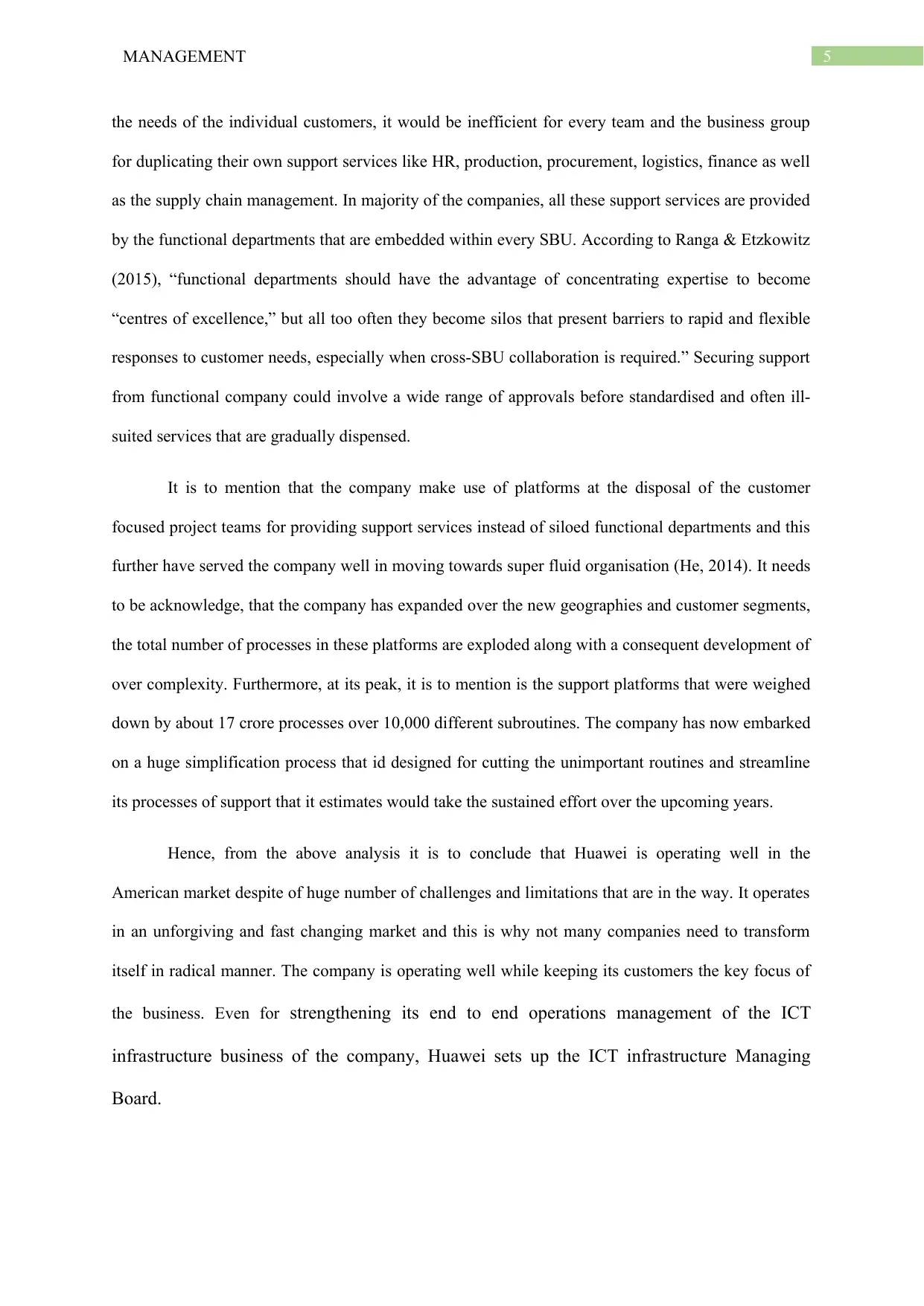
5MANAGEMENT
the needs of the individual customers, it would be inefficient for every team and the business group
for duplicating their own support services like HR, production, procurement, logistics, finance as well
as the supply chain management. In majority of the companies, all these support services are provided
by the functional departments that are embedded within every SBU. According to Ranga & Etzkowitz
(2015), “functional departments should have the advantage of concentrating expertise to become
“centres of excellence,” but all too often they become silos that present barriers to rapid and flexible
responses to customer needs, especially when cross-SBU collaboration is required.” Securing support
from functional company could involve a wide range of approvals before standardised and often ill-
suited services that are gradually dispensed.
It is to mention that the company make use of platforms at the disposal of the customer
focused project teams for providing support services instead of siloed functional departments and this
further have served the company well in moving towards super fluid organisation (He, 2014). It needs
to be acknowledge, that the company has expanded over the new geographies and customer segments,
the total number of processes in these platforms are exploded along with a consequent development of
over complexity. Furthermore, at its peak, it is to mention is the support platforms that were weighed
down by about 17 crore processes over 10,000 different subroutines. The company has now embarked
on a huge simplification process that id designed for cutting the unimportant routines and streamline
its processes of support that it estimates would take the sustained effort over the upcoming years.
Hence, from the above analysis it is to conclude that Huawei is operating well in the
American market despite of huge number of challenges and limitations that are in the way. It operates
in an unforgiving and fast changing market and this is why not many companies need to transform
itself in radical manner. The company is operating well while keeping its customers the key focus of
the business. Even for strengthening its end to end operations management of the ICT
infrastructure business of the company, Huawei sets up the ICT infrastructure Managing
Board.
the needs of the individual customers, it would be inefficient for every team and the business group
for duplicating their own support services like HR, production, procurement, logistics, finance as well
as the supply chain management. In majority of the companies, all these support services are provided
by the functional departments that are embedded within every SBU. According to Ranga & Etzkowitz
(2015), “functional departments should have the advantage of concentrating expertise to become
“centres of excellence,” but all too often they become silos that present barriers to rapid and flexible
responses to customer needs, especially when cross-SBU collaboration is required.” Securing support
from functional company could involve a wide range of approvals before standardised and often ill-
suited services that are gradually dispensed.
It is to mention that the company make use of platforms at the disposal of the customer
focused project teams for providing support services instead of siloed functional departments and this
further have served the company well in moving towards super fluid organisation (He, 2014). It needs
to be acknowledge, that the company has expanded over the new geographies and customer segments,
the total number of processes in these platforms are exploded along with a consequent development of
over complexity. Furthermore, at its peak, it is to mention is the support platforms that were weighed
down by about 17 crore processes over 10,000 different subroutines. The company has now embarked
on a huge simplification process that id designed for cutting the unimportant routines and streamline
its processes of support that it estimates would take the sustained effort over the upcoming years.
Hence, from the above analysis it is to conclude that Huawei is operating well in the
American market despite of huge number of challenges and limitations that are in the way. It operates
in an unforgiving and fast changing market and this is why not many companies need to transform
itself in radical manner. The company is operating well while keeping its customers the key focus of
the business. Even for strengthening its end to end operations management of the ICT
infrastructure business of the company, Huawei sets up the ICT infrastructure Managing
Board.
⊘ This is a preview!⊘
Do you want full access?
Subscribe today to unlock all pages.

Trusted by 1+ million students worldwide
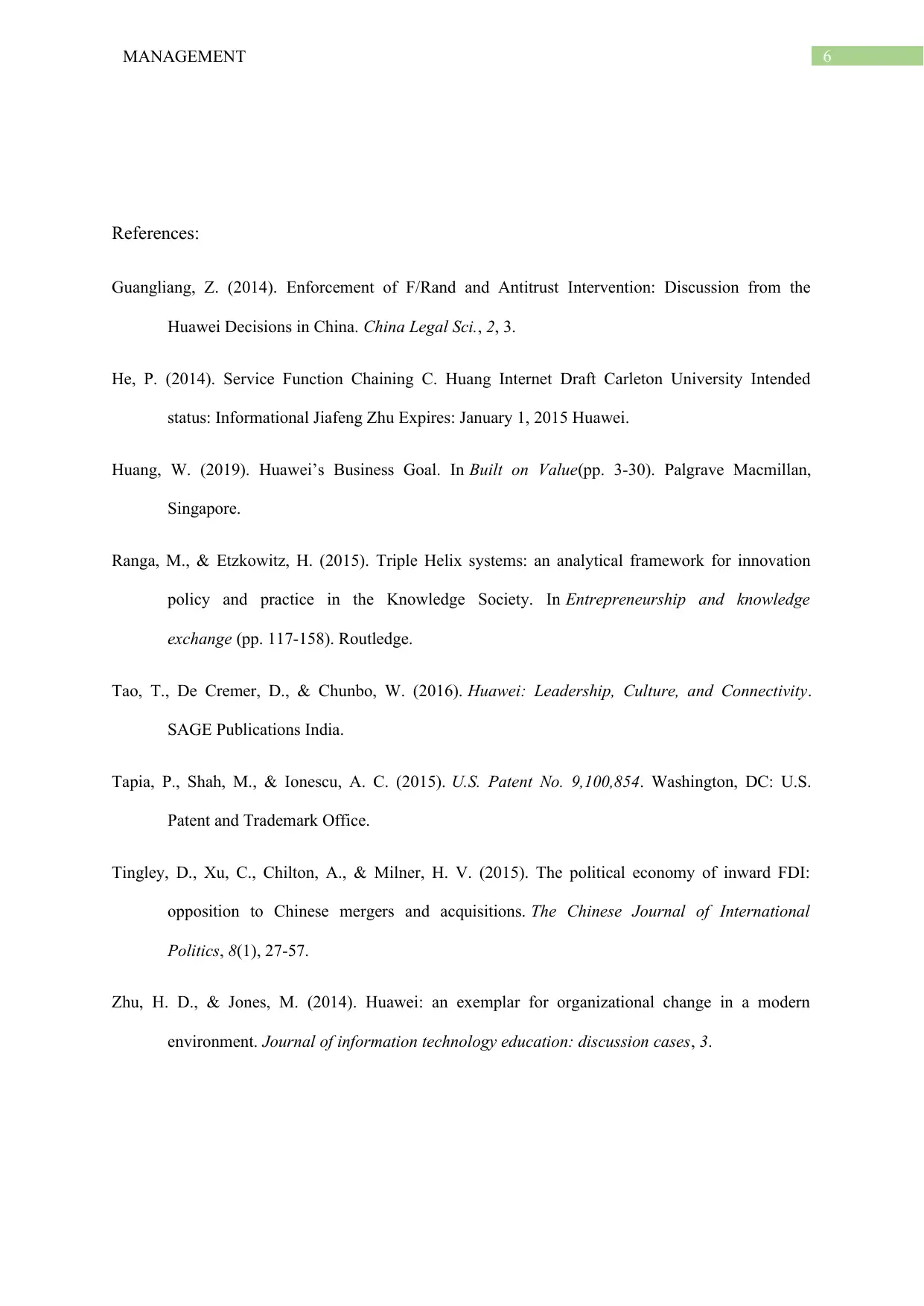
6MANAGEMENT
References:
Guangliang, Z. (2014). Enforcement of F/Rand and Antitrust Intervention: Discussion from the
Huawei Decisions in China. China Legal Sci., 2, 3.
He, P. (2014). Service Function Chaining C. Huang Internet Draft Carleton University Intended
status: Informational Jiafeng Zhu Expires: January 1, 2015 Huawei.
Huang, W. (2019). Huawei’s Business Goal. In Built on Value(pp. 3-30). Palgrave Macmillan,
Singapore.
Ranga, M., & Etzkowitz, H. (2015). Triple Helix systems: an analytical framework for innovation
policy and practice in the Knowledge Society. In Entrepreneurship and knowledge
exchange (pp. 117-158). Routledge.
Tao, T., De Cremer, D., & Chunbo, W. (2016). Huawei: Leadership, Culture, and Connectivity.
SAGE Publications India.
Tapia, P., Shah, M., & Ionescu, A. C. (2015). U.S. Patent No. 9,100,854. Washington, DC: U.S.
Patent and Trademark Office.
Tingley, D., Xu, C., Chilton, A., & Milner, H. V. (2015). The political economy of inward FDI:
opposition to Chinese mergers and acquisitions. The Chinese Journal of International
Politics, 8(1), 27-57.
Zhu, H. D., & Jones, M. (2014). Huawei: an exemplar for organizational change in a modern
environment. Journal of information technology education: discussion cases, 3.
References:
Guangliang, Z. (2014). Enforcement of F/Rand and Antitrust Intervention: Discussion from the
Huawei Decisions in China. China Legal Sci., 2, 3.
He, P. (2014). Service Function Chaining C. Huang Internet Draft Carleton University Intended
status: Informational Jiafeng Zhu Expires: January 1, 2015 Huawei.
Huang, W. (2019). Huawei’s Business Goal. In Built on Value(pp. 3-30). Palgrave Macmillan,
Singapore.
Ranga, M., & Etzkowitz, H. (2015). Triple Helix systems: an analytical framework for innovation
policy and practice in the Knowledge Society. In Entrepreneurship and knowledge
exchange (pp. 117-158). Routledge.
Tao, T., De Cremer, D., & Chunbo, W. (2016). Huawei: Leadership, Culture, and Connectivity.
SAGE Publications India.
Tapia, P., Shah, M., & Ionescu, A. C. (2015). U.S. Patent No. 9,100,854. Washington, DC: U.S.
Patent and Trademark Office.
Tingley, D., Xu, C., Chilton, A., & Milner, H. V. (2015). The political economy of inward FDI:
opposition to Chinese mergers and acquisitions. The Chinese Journal of International
Politics, 8(1), 27-57.
Zhu, H. D., & Jones, M. (2014). Huawei: an exemplar for organizational change in a modern
environment. Journal of information technology education: discussion cases, 3.
1 out of 7
Related Documents
Your All-in-One AI-Powered Toolkit for Academic Success.
+13062052269
info@desklib.com
Available 24*7 on WhatsApp / Email
![[object Object]](/_next/static/media/star-bottom.7253800d.svg)
Unlock your academic potential
Copyright © 2020–2025 A2Z Services. All Rights Reserved. Developed and managed by ZUCOL.




